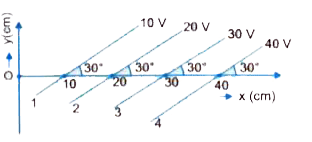Two indentical plane metallic surfaces A and B are kept parallel to each other in air separated by a distance of 1 cm,

surface A is given a positive potential of 10 V and the outer surface of B is earthed.
What is the magnitude and direction of the electric field between the points Y and Z ? Solution in Odia
−103 V/m, the direction of electric field is from plate A to plate B,
Similar Questions
On the basis of your understanding of the following paragraph and the related studied concepts. An equipotential surface is a surface with a constant value of electric potential at all points on the surface. The component of electric field parallel to an equipotential surface is zero, as the potential does not change in this direction. Thus, the electric field is perpendicular to the equipotential surface at each point of the surface. Further, say the direction of electric field electrical potential gradually fall with distance. If electric potential at origin point O be 100 V, then for electric field specified in part (b), draw equipotential surfaces corresponding to potentials 80 V, 60 V and 40 V respectively.
View SolutionOn the basis of your understanding of the following paragraph and the related studied concepts.
An equipotential surface is a surface with a constant value of electric potential at all points on the surface. The component of electric field parallel to an equipotential surface is zero, as the potential does not change in this direction. Thus, the electric field is perpendicular to the equipotential surface at each point of the surface. Further, say the direction of electric field electrical potential gradually fall with distance.
Four equipotential surfaces are shown in the adjoining figure. Find the magnitude and direaction of the electric field.

View SolutionOn the basis of your understanding of the following paragraph and the related studied concepts.
An equipotential surface is a surface with a constant value of electric potential at all points on the surface. The component of electric field parallel to an equipotential surface is zero, as the potential does not change in this direction. Thus, the electric field is perpendicular to the equipotential surface at each point of the surface. Further, say the direction of electric field electrical potential gradually fall with distance.
If a charge of 2 nC is taken from equipotential surface number 2 to 3, what is the amount of work done ?
View SolutionTwo closely spaced equipotential surfaces A and B with potentials V and V + deltaV (where SV is the change in V) are kept 8l distance apart as shown in the Fig. Deduce the relation between the electric field and the potential gradient between them. Write the two important conclusions concerning the relation between the electric field and the electric potential.
View SolutionTwo large parallel conducting plates are placed close to each other ,the inner surface of the two plates have surface charge densities +σ and −σ .The outer surfaces are without charge.The electric field has a magnitude of
View SolutionTwo large metal plates are placed parallel to each other. The inner surface of the plates are charged by +σ and −σ(coulomb/m2), the outer surface are neutral. The electric field is in the region between the plates and outside the plates.
View SolutionTwo large metal plates are placed parallel to each other The inner surfaces of plates are charge by +sigmaand-sigma(Cm^(-2)) The outer surfaces are neutral .The electric field in the negion between the plates and outside the plates is
View SolutionTwo identical plane metallic surfaces A and B are kept parallel to each other in air separated by a distance of 10 cm as shown in Figure. Surface A is given a positive Potential of 10 V and outer surface of B is earthed. What is the magnitude and directions of uniform electric field between points Y and Z?
View Solution
